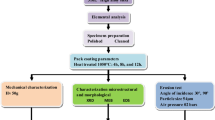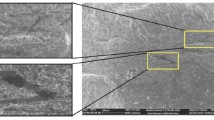Abstract
In technical practice, increasing wear resistance can be done in a variety of methods. However, most of them are technologically, time, and energy intensive, and the costs incurred frequently outweigh the benefits received. This study aims at surface modification of the selected grades of steels (25CrMo4, 30CrMoV9, 41CrAlMo7) through the TIG (tungsten inert gas) remelting process using a CaCN2-based powder. TIG remelting process was conducted in the shielding atmosphere of 99.996% argon (argon 4.6) at a gas flow of 10 l·min−1 and a welding current of 110 A. After remelting, the microstructure of the generated layers was analysed using scanning electron microscopy (SEM) and the hardness of newly formed layers was evaluated using a microhardness machine. In all of the tested steels, nitrogen had a favourable impact on the rise in hardenability, which resulted in a notable increase in hardness and resistance to abrasive wear. A significant increase in hardness and abrasive wear resistance was achieved up to a depth of 1–1.5 mm from the surface in the case of all steels through the remelting process. The effect of nitrogen on the increase in the investigated properties is documented by a comparison of samples remelted in the absence and presence of CaCN2-based powder. The most significant increases of both parameters under investigation were attained in 25CrMo4 steel, which had the most considerable nitrogen enrichment. This method represents a cheap, technologically available, and fast way of forming surface layers with increased hardness and wear resistance, which makes it applicable in engineering, agriculture, earthworks, etc.










Similar content being viewed by others
References
Ťavodová M, Kalincová D, Kotus M, Pavlík Ľ (2018) The possibility of increasing the wearing resistance of Mulcher tools. Acta Technol Agric 2:87–93. https://doi.org/10.2478/ata-2018-0016
Hrabě P, Müller M (2013) Research of overlays influence on ploughshare lifetime. Res Agr Eng 59:147–152. https://doi.org/10.17221/3/2013-rae
Sabet H, Khierandish Sh, Mirdamadi Sh, Goodarzi M (2011) The microstructure and abrasive wear resistance of Fe-Cr-C hardfacing alloys with the composition of hypoeutectic, eutectic, and hypereutectic at Cr/C=6. Tribol Lett 44:237–245. https://doi.org/10.1007/s11249-011-9842-2
Kešner A, Chotěborský R, Linda M (2017) The effect of microstructure on abrasive wear of steel. IOP Conf Ser: Mater Sci Eng 237:012040. https://doi.org/10.1088/1757-899X/237/1/01240
Buchely MF, Gutierrez JC, León LM, Toro A (2005) The effect of microstructure on abrasive wear of hardfacing alloys. Wear 259:52–61. https://doi.org/10.1016/j.wear.2005.03.002
Chintha AR (2019) Metallurgical aspects of steels designed to resist abrasion, and impact-abrasion wear. Mater Sci Technol 35(10):1133–1148. https://doi.org/10.1080/02670836.2019.1615669
Kostryzhev AG (2021) Strengthening mechanisms in metallic materials Metals 11(7):1134. https://doi.org/10.3390/met11071134
Davis JR (2002) Surface hardening of steels: understanding the basics. ASM International, Materials Park
Yuan X, Zhao Y, Li X, Chen L (2017) Effects of gas nitriding temperature on the surface properties of a high manganese TWIP steel. Metals 7:102. https://doi.org/10.3390/met7030102
Li Y, Wang Zh, Wang L (2014) Surface properties of nitrided layer on AISI 316L austenitic stainless steel produced by high temperature plasma nitriding in short time. Appl Surf Sci 298:243–250. https://doi.org/10.1016/j.apsusc.2014.01.177
Kusmič D, Hrubý V, Bachárová L (2016) Corrosion resistance of surface treated 42CrMo4 steel. Kovove Mater 54:491–496. https://doi.org/10.4149/km_2016_6_491
Ruihua Zh, Linhai T, Mingdong B, Yong M, Bin T (2012) Wear properties of plasma nitrided H13 steel at room and elevated temperature. Rare Met Mater Eng 41:203–206
Czerwinski F (2012) Thermochemical treatment of metals. In: Heat Treatment. Conventional and Novel Applications. IntechOpen, London, pp. 73–112. https://doi.org/10.5772/51566
Turk A, Bindal C (2008) Characterization of plasma nitrided X32CrMoV33 die steel. Mater Manuf Process 24:898–902. https://doi.org/10.1080/10426910902844278
Kurz R (1970) Application of powder nitriding in relation to bath nitriding (Tenifer-process) (in German). Z Werkstofftech 3:124–126
Godec M, Podgornik B, Kocijan A, Črtomir D, Skobir Balantič D (2021) Use of plasma nitriding to improve the wear and corrosion resistance of 17Ni-300 maraging steel manufactured by selective laser melting. Sci Rep 11:3277. https://doi.org/10.1038/s41598-021-82572-y
Kaszuba M (2020) The application of a new, innovative, hybrid technology combining hardfacing and nitriding to increase the durability of forging tools. Arch Civ Mech Eng 20:122. https://doi.org/10.1007/s43452-020-00122-1
Ageev M, Lopata L, Smirnova T, Dudan A, Lopata A (2019) Of combined electric arc coatings. Problems of Tribology 24:51–61. https://doi.org/10.31891/2079-1372-2019-93-3-51-61
Orečný M, Buršák M, Šebek M, Falat L (2016) Influence of hardness, matrix and carbides in combination with nitridation on abrasive wear resistance of X210Cr12 tool steel. Metals 6:236. https://doi.org/10.3390/met6100236
Müller M, Chotěborský R, Hrabě P (2019) Application of overlay material on soil processing tools for purpose of increasing their abrasive wear resistance (in Czech). Listy Cukrov Repar 131:279–283
Coronado JJ, Caicedo HF, Gómez AL (2009) The effects of welding processes on abrasive wear resistance for hardfacing deposits. Tribol Int 42:745–749. https://doi.org/10.1016/triboint.2008.10.012
Królicka A, Szczepański Ł, Konat Ł, Stawicki T, Kostencki P (2020) The influence of microstructure on abrasive wear micro-mechanisms of the claddings produced by welding used in agricultural soil. Materials 13:1920. https://doi.org/10.3390/ma13081920
Xu T, Wei Ch, Han X, Liu J, He Zh, Lü N (2020) Effect of carbon and elements Mo and V on the microstructure and properties of stainless-steel powder surfacing layer. Coatings 10:371. https://doi.org/10.3390/coatings10040371
Appiah ANS, Bialas O, Czupriński A, Adamiak M (2022) Powder plasma transferred arc welding of Ni-Si-B + 60 wt% WC and Ni-Cr-Si-B + 45 wt% WC for surface cladding of structural steel. Materials 15:4956. https://doi.org/10.3390/ma15144956
Šebek M, Falat L, Orečný M, Petryshynets I, Kováč F, Černík M (2018) Abrasive wear resistance of modified X37CrMoV5-1 hot work tool steel after conventional and laser heat treatment. Int J Mater Res (formerly Z Metallkd) 109:5. https://doi.org/10.3139/146.111624
Cunha A, Marques A, Silva MR, Bartolomeu F, Silva FS, Gasik M, Trindade B, Carvalho Ó (2022) Laser powder bed fusion of the steels used in the plastic injection mould industry: a review of the influence of processing parameters on the final properties. J Adv Manuf Technol 121:4255–4287. https://doi.org/10.1007/s00170-022-09588-0
Dyuti S, Mridha S, Shaha SK (2011) Wear behaviour of modified surface layer produced by TIG melting of preplaced Ti powder in nitrogen environment. Adv Mat Res 264–265:1427–1432. https://doi.org/10.4028/www.scientific.net/AMR.264-265.1427
Dyuti S, Mridha S, Shaha SK (2010) Surface modification of mild steel using tungsten inert gas torch surface cladding. Am J Appl Sci 7:815–820. https://doi.org/10.3844/ajassp.2010.815.822
Buytoz S, Ulutan M, Yildirim MM (2005) Dry sliding wear behaviour of TIG welding clad WC composite coatings. Appl Surf Sci 252:1313–1323. https://doi.org/10.1016/j.apsusc.2005.02.088
Lailatul PH, Maleque MA (2017) Surface modification of duplex stainless steel with SiC preplacement using TIG torch cladding. Procedia Eng 184:737–742. https://doi.org/10.1016/proeng.2017.04.151
Mridha S, Md Idriss AN, Maleque MA, Yaacob II, Baker TN (2015) Melting of multipass surface tracks in steel incorporating titanium carbide powders. Mater Sci Technol 31:1362–1369. https://doi.org/10.1079/1743284714Y.0000000712
Xu H, Sun J, Jin J, Song J, Wang C (2021) Comparison of structure and properties of Mo2FeB2-based cermets prepared by welding metallurgy and vacuum sintering. Materials 14:46. https://doi.org/10.3390/ma14010046
Zhu L, Cui Y, Cao J, Tian R, Cai Y, Xu Ch, Han J, Tian Y (2021) Effect of TIG remelting on microstructure, corrosion and wear resistance of coating on surface of 4Cr5MoSiV1 (AISI H13). Surf Coat Technol 405:126547. https://doi.org/10.1016/j.surfcoat.2020.126547
Tsvetkova E, Bazaleeva K, Smirnov A, Chekin I (2018) Nitriding of martensitic steel after laser melting deposition. IOP Conf Series: Journal of Physics: Conf Series 1109:012054. https://doi.org/10.1088/1742-6596/1109/1/012054
Yuan J, Dong T, Fu B, Li G, Wang R (2019) Effect of tungsten inert gas arc remelting on microstructure and wear properties of plasma-sprayed NiCr-Cr3C2 coating. J Mater Eng Perform 28:6320–6329. https://doi.org/10.1007/s11665-019-04350-2
Li G, Li Y, Dong T, Wang H, Zheng X, Zhou X (2018) Microstructure and wear resistance of TIG remelted NiCrBSi thick coatings. Adv Mater Sci Eng. https://doi.org/10.1155/2018/8979678
Kolodziejczak P, Bober M, Chmielewski T (2022) Wear resistance comparison research of high-alloy protective coatings for power industry prepared by means of CMT cladding. Appl Sci 12:4568. https://doi.org/10.3390/app12094568
Xue H, Luan X, Guo W, Zhou D (2022) Microstructure and properties of TIG surfacing Co-based alloy on UMCo50 process burner. Arch Metall Mater 67(1):17–30. https://doi.org/10.24425/amm.2022.137467
Coro A, Macareno LM, Aguirrebeitia J, López de Lacalle LN (2019) A methodology to evaluate the reliability impact of the replacement of welded components by additive manufacturing spare parts. Metals 9:932. https://doi.org/10.3390/met9090932
Kováč I, Mikuš R, Žarnovský J, Drlička R, Žitňanský J, Výrostková A (2014) Creation of wear resistant boride layers on selected steel grades in electric arc remelting process. Kovove Mater 52(6):387–394. https://doi.org/10.4149/km_2014_6_387
Basso AD, Toda-Caraballo I, Eres-Castellanos A, San-Martin D, Jimenez JA, Caballero FG (2020) Effect of the microsegregation on martensitic and bainitic reactions in a high carbon-high silicon cast steel. Metals 10:574. https://doi.org/10.3390/met10050574
Dziedzic A, Adamiak S (2010) The comparison of the structure and microhardness of the tool steel C90 and HS 6-5-2 remelted with electric arc. Arch Foundry Eng 10(2):39–42
Adamiak S (2012) Structure of X5CrNi18-10 and S355NL steels after remelting with electric arc. Arch Foundry Eng 12(2):139–142. https://doi.org/10.2478/v10266-012-0052-7
Šebek M, Falat L, Kováč F, Petryshynets I, Horňak P, Girman V (2017) The effects of laser surface hardening on microstructural characteristics and wear resistance of AISI H11 hot tool steel. Arch Metall Mater 62(3):1721–1726. https://doi.org/10.1515/amm-2017-0262
Surian E, Trotti J, Cassanelli A, De VLA (1994) Influence of chromium on the mechanical properties and microstructure of weld metal from high-strength SMA electrode. Weld J 73(3):45–53
Kim WY, Lee ChO, Yun ChW, Pak JJ (2009) Effect of chromium on nitrogen solubility in liquid Fe–Cr alloys containing 30 mass% Cr. ISIJ Int 49(11):1668–1672
Jang JM, Seo SH, Jiang M, Paek MK, Wang X, Pak JJ (2014) Nitrogen solubility in liquid Fe-C alloys. ISIJ Int 54(1):32–36. https://doi.org/10.2355/isijinternational.54.32
Speelmanns IM, Schmidt MW, Liebske Ch (2018) Nitrogen solubility in core materials. Geophys Res Lett 45:7434–7443. https://doi.org/10.1029/2018GL079130
Brunski JB (2013) Metals: basic principles. In: Biomaterials Science: An Introduction to Materials in Medicine. 3rd ed. Elsevier Inc. p. 117
López de Lacalle LN, Gutiérrez A, Lamikiz A, Fernandes MH, Sánchez JA (2000) Turning of thick thermal spray coatings. J Therm Spray Technol 10:249–254. https://doi.org/10.1361/105996301770349349
Acknowledgements
The authors also would like to thank Dr. Ladislav Falat (Institute of Materials Research, Slovak Academy of Sciences, Košice, Slovakia) for the help in performing microstructural and EDX analyses.
Funding
This work was supported by KEGA, grant number 063TUKE-4/2021 and by VEGA, grant number 1/0236/21.
Author information
Authors and Affiliations
Contributions
Ivan Kováč: conceptualisation, experimental plan, initial experiments. Rastislav Mikuš: experiment performing, manuscript writing. Jozef Žarnovský: material preparation, editing. Róbert Drlička: material preparation, data analysis. Marta Harničárová: manuscript writing, data analysis. Jan Valíček: conceptualisation, supervision. Milan Kadnár: data curation and project administration. All authors read and approved the final manuscript.
Corresponding author
Ethics declarations
Conflict of interest
The authors declare no competing interests.
Additional information
Publisher's Note
Springer Nature remains neutral with regard to jurisdictional claims in published maps and institutional affiliations.
Rights and permissions
Springer Nature or its licensor (e.g. a society or other partner) holds exclusive rights to this article under a publishing agreement with the author(s) or other rightsholder(s); author self-archiving of the accepted manuscript version of this article is solely governed by the terms of such publishing agreement and applicable law.
About this article
Cite this article
Kováč, I., Mikuš, R., Žarnovský, J. et al. Increasing the wear resistance of surface layers of selected steels by TIG electric arc surface remelting process using a powder based on CaCN2. Int J Adv Manuf Technol 123, 1985–1997 (2022). https://doi.org/10.1007/s00170-022-10316-x
Received:
Accepted:
Published:
Issue Date:
DOI: https://doi.org/10.1007/s00170-022-10316-x




